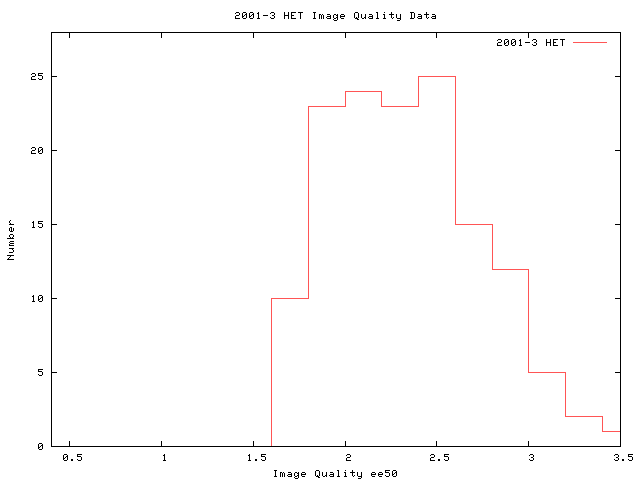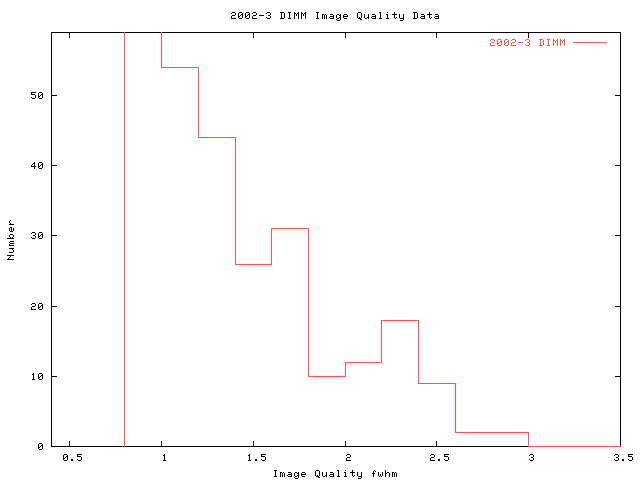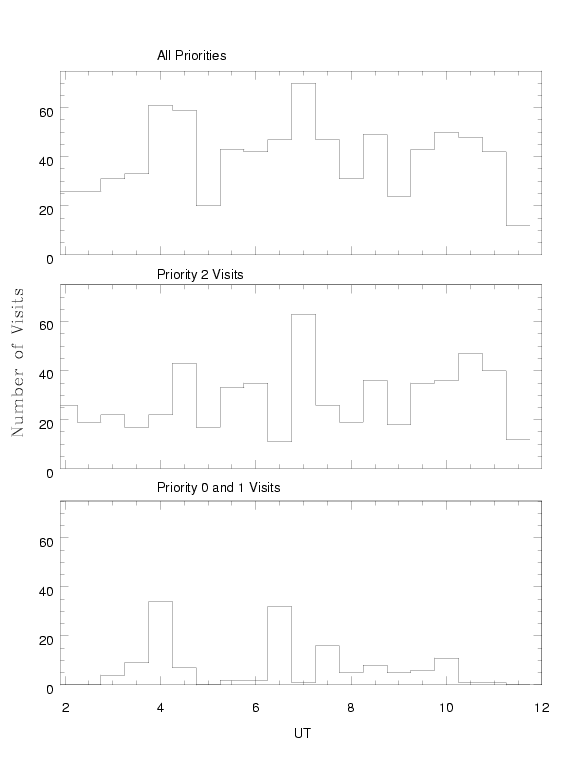
In this section we will discuss the status of each instrument and any limitation to configurations that occurred during the period.
The image quality of the HET has improved a bit over last year.

For comparison here is the image quality for the same period of 2001

Here are the DIMM values reported in the night report. NOTE: There are a large number of nights when the DIMM was not operated; there is also times when the DIMM failed due to wind shake or extremely bad seeing.

Month by Month Summary
| Month | A:Fraction of the Time that was Possible Science | B:Average Night Length | C:Fraction of Time Lost due to Weather | D:Fraction of Science Time Lost due to Alignment | E:Fraction of Science Time Lost due to Calibrations | F:Fraction of Science Time Lost due to Problems |
|---|---|---|---|---|---|---|
| August | 0.884 | 7:52 | 0.38 | 0.24 | 0.02 | 0.09 |
| September | 0.843 | 8:56 | 0.27 | 0.13 | 0.04 | 0.53 |
The total number of 386 acceptable shutter open science exposures during this period for a total of 55.3 hours. There were a number of rejected spectra obtained during this period as well the following table give the total number of rejected spectra and the category that each falls into.
| Number of Times | Time Lost (Hours) | Type |
|---|---|---|
| 11 | 1.9 | E - Rejected by RA for Equipment Failure |
| 2 | 0.5 | H - Rejected by RA for Human failure |
| 18 | 3.4 | W - Rejected by RA for Weather |
| 1 | 0.6 | P - Rejected by PI and confirmed by RA |
| 0 | 0.0 | Q - Rejected due to error in the queue |
| 0 | 0.0 | C - Acceptable by RA but PI rejects |
| 0 | 0.0 | N - Acceptable but NOT charged due to weather or hole in queue |
| 26 | 3.2 | B - Acceptable but Border line conditions |
So this is a total of 6.4 hours of rejected spectra with an additional possible 3.2 hours of spectra that may be rejected.
This was the first period that we have kept accurate statistics on the overhead for each science visit. This overhead includes slew, setup, and readout (if there are multiple exposures per visit). In the summary page for each program the average setup time is calculated. The table below gives the average setup time for each instrument and the average and maximum science exposures.
| Instrument | Avg Overhead (min) | Avg Exposure (sec) | Max Exposure (sec) |
|---|---|---|---|
| LRS | 12.4 | 829.8 | 2222 |
| HRS | 11.5 | 833.0 | 1800 |
The following links give the summary for each institution and its programs.
The resulting table will give (for each program) the total number of targets
in the queue and the number completed, and will give the CCD shutter open
hours, 10 minute overhead per visit, and the TAC allocated time.
This usually will be the best
metric for judging completeness but there are times when a PI will tell
us that a target is "done" before the total number of visits is complete.
The following is a summary of the Acceptable CCD shutter time for each
institution based on our htopx data base. It does not include any
overhead.
Observing Programs Status
Program comments:
UT02-3-003: (Shields) TOO program with no targets submitted
UT02-3-005: (Robinson) Synoptic program completed
UT02-3-009: (Paulson) No Phase II ever received.
UT02-3-012: (Endl) GJ623 added late and is now near twilight.
UT02-3-015: (Wheeler) TOO program with no targets submitted
Program comments:
PSU02-3-008: (Eracleous) GRB TOO.
PSU02-3-047: (Schneider) No Phase II ever received.
PSU02-3-048: (Brandt) 2 remaining targets not yet available.
PSU02-3-049: (Mandell) All submitted targets complete.
PSU02-3-050: (Ge) Synoptic targets with 4 possible times, 1st lost due to PI error and another due to HEX failure
PSU02-3-051: (TAC) TAC discretionary time.
PSU02-3-052: (Richards) Target submitted late in 2nd month.
PSU02-3-053: (Schneider) All submitted targets complete.
Program comments:
Program comments:
MUN02-3-001: (Botzler) MOS setup images; all targets at the end of the night
Program comments:
G02-3-001: (Kollatschny) Synoptic target with visits every 4-6 days
Institution Status
| Time Usage by Institution (hours) | ||||
|---|---|---|---|---|
| -TOTAL- | Used | % of All | ||
| PSU | 11.236 | 15.4 | ||
| UT | 51.664 | 72.9 | ||
| Stanford | 6.500 | 8.9 | ||
| Munich | 0.000 | 0.0 | ||
| Goetting | 2.000 | 2.7 | ||
| NOAO | 3.383 | -- | ||
| SALT | 0.000 | -- | ||
| DDT | 0.000 | -- | ||
This is how each institution has allocated its time by priority.
| Time Allocation by Institution (hours) | |||||
|---|---|---|---|---|---|
| Institution | Priority 0 | Priority 1 | Priority 2 | Priority 3 | Priority 4 |
| PSU | 3.000 (3%) | 31.500 (30%) | 35.000 (34%) | 35.000 (34%) | 0.000 |
| UT | 19.200 (10%) | 51.000 (26%) | 101.500 (51%) | 27.000 (14%) | 0.000 |
| Stanford | 0.000 | 5.000 (24%) | 12.000 (57%) | 3.000 (14%) | 1.000(5%) |
| Munich | 0.000 | 4.083 (41%) | 2.917 (29%) | 3.000 (30%) | 0.000 |
| Goetting | 0.000 | 0.000 | 0.000 | 0.000 | 0.000 |
| NOAO | 0.000 | 53.700 (56%) | 42.600 (44%) | 0.000 | 0.000 |
| SALT | 0.000 | 0.000 | 0.000 | 0.000 | 0.000 |
| DDT | 0.000 | 0.000 | 0.000 | 0.000 | 0.000 |
| UT02-2 | ||
|---|---|---|
| Rank | Program | Constraints |
| 1 | UT02-3-010 | HRS, many synoptic visits for 2 different targets, Vsky > 20.3 ,EE50 < 2.0 |
| 2 | UT02-3-002, N6702 | LRS, 1 track, photometric , Vsky > 21.0, EE50 < 4.0 |
| 3 | UT02-3-012, GJ623, GJ87 | HRS, 3 tracks, Vsky > 20.0, EE50 < 2.5 |
| PSU02-2 | ||
|---|---|---|
| Rank | Program | Constraints |
| 1 | PSU02-2-053 | LRS, 1 target, Vsky > 21.0 EE50 < 2.5 |
| 2 | PSU02-2-050 | HRS, 2 long visits on 2 possible dates, Vsky > 18.0, EE50 < 4.0 |
| 3 | PSU02-2-046 sd39,sd50 | HRS, 2 targets, Vsky > 20.5, EE50 < 2.7 |
| STA02-2 | ||
|---|---|---|
| Rank | Program | Constraints |
| 1 | STA02-3-001, CSBS 3674 3678 3697 3850 2699 | LRS, Vsky > 21.0 , EE50 < 2.5 |
| MUN02-2 | ||
|---|---|---|
| Rank | Program | Constraints |
| - | ||
| G02-2 | ||
|---|---|---|
| Rank | Program | Constraints |
| 1 | G02-3-001 | LRS, Synoptic target every 4-6 days for entire trimester, Vsky > 18.5 , EE50 < 4.0 |

Larry Ramsey asked that in the next period that the Median exposure length be given in addition to the Average exposure length for the different instruments.
Roger Romani asked that we include CSBS 1554 and CSBS 2292 in our high priority catagory for the coming weeks. Also we should try to hit CSBS 3674, 3678 & 3697 one after another to improve efficiency.
Rob Robinson asked that we should observe Gary Hill's program UT02-3-008 as our next highest priority.
The entire group agreed that by the end of the period that Munich and Penn State should be closer to their proportion of HET time.
For the next TAC report we will put definitions of how the different fractions in the month by month summary are calculated.